ASUS TUF Gaming A15 review (FA506QR – Ryzen 7 5800H, RTX 3070)
While controversial because of its limited (even subpar, by some standards) cooling implementation, the ASUS TUF Gaming series has been one of the best selling mid-range gaming laptops of the past years, thanks to competitive pricing and fair value.
We’ve reviewed the previous TUF models and we agree they tend to run hot, especially in the higher-specced variants, that’s why our previous recommendations have gone towards the mid-range configurations instead.
Early into 2021, ASUS have updated the TUF A15 series with 2021 hardware – AMD Ryzen 5000 H processors and Nvidia RTX 3000 graphics, a better screen option – 240 Hz panel with 3 ms response and 100% sRGB colors, and an updated internal thermal design with what looks like improved air intakes on the bottom.
At the same time, the 2021 ASUS TUF Gaming A15 series offers higher-tier and higher-power graphics, so we were eager to find out how all these tweaks fair up in real-life use.
We’ve spent time with an early retail version of the ASUS TUF Gaming A15 FA506QR model, built on the Ryzen 7 5800H processor, 16 GB of DDR4 RAM, 1TB of SSD storage, and an Nvidia RTX 3070 MQ dGPU that runs at ~95W in sustained loads, and gathered our thoughts in this article.
Keep in mind that while this laptop is identical to the ones you can get in stores right now, available over here for around 1500 EUR, we’re running our tests on the early BIOS and drivers available as of late January 2021, so certain aspects might change with future software tweaks. We’ll follow-up in later articles where required, and we’d greatly appreciate your feedback and questions on what we should further test on this laptop.
Update: As of January 28th, there’s an updated BIOS from Asus, as well as new GeForce drivers. We’re updated some of the test results and findings.
Specs as reviewed – ASUS TUF A15 FA506QR 2021
2021 ASUS TUF Gaming A15 FA506QR
Display
15.6-inch, 16:9, non-touch, matte, Sharp LQ156M1JW26 panel
FHD 1920 x 1080 px IPS, 240 Hz 3ms with 100% sRGB, with AdaptiveSync
Processor
AMD Cezanne, Ryzen 7 5800H, 8C/16T
Video
AMD Radeon Vega + Nvidia GeForce RTX 3070 Laptop 8GB (up to 95W, GeForce 461.23 drivers)
Memory
16 GB DDR4 3200 MHz (2x DIMMs, up to 32 GB)
Storage
1 TB NVMe SSD (2x M.2 PCI x4 slots)
Connectivity
Gigabit LAN, Wireless 6 2×2, Bluetooth 5.1
Ports
2x USB-A 3.2, 1x USB-A 2.0, 1x USB-C gen 2 with DP and data, HDMI 2.0b, LAN, headphone/mic, Kensington Lock
Battery
90 Wh, 200 W power adapter
Size
360 mm or 14.17” (w) x 256 mm or 10.079” (d) x 24.9 mm or .98” (h)
Weight
2.23 kg (4.9 lbs), .59 kg (1.3 lbs) power brick and cables, EU version
Extras
single-zone RGB backlit keyboard, webcam, stereo speakers
While our model is the top-tier 2021 TUF A15 configuration, lower-tier variants will also be available, with Ryzen 5/7 processors and RTX 3060/3070 graphics at launch, as well as lower-tier dGPUs once those are available, later in the year.
Update: The TUF Gaming series has been completely revamped for the new year, and you’ll find all about this from this article on the 2022 TUF Gaming A15/F15 series, as well as from this review of the 2022 TUF Gaming A15 model.
Design and construction
Not much has changed with the 2021 TUF A15 in terms of the overall design and build lines, with two exceptions: the lid looks a little different and the bottom has been remade in order to allow better air intake into the fans.
That means this laptop is still mostly made out of plastic, with a textured black interior and rougher materials used for the underside and bezels. The interior feels OK for the class and comfortable with daily use. The blunted edges and corners help with the experience, but overall there’s nothing fancy about this laptop, which instead feels more inclined to be reliable and spartan (just as the previous TUFs, this meets a couple of MIL standards for reliability, explained on Asus’s website).
Those black plastics should age well and not scratch as easily as metal would, but the black surfaces gather smudges and finger oil fairly easily, so you’ll need to wipe them clean often.
As for the underside, that’s also plastic and houses cuts for the speakers and air intakes, as well as some grippy, but slim rubber feet. We’ll get in-depth about those in the Thermals section down below.
Branding is fairly minimal on the inside of this TUF A15, with a dark ASUS logo under the screen and TUF Gaming engraved on the main-body, beneath the display, and next to the status LEDs. They’re dim and hardly visible even in darker rooms, but I do proffer designs that send them to the sides. Speaking of, the power button still integrates an annoying always-on red light on this series.
As for the lid, that’s available in two different versions: one made of textured black plastic, reserved for the lower-tier configurations, and another made out of smooth dark-gray aluminum, the one we have here. Asus cleaned-up the TUF logo for this generation and moved it from the middle of the lid to the corner on this metallic variant, but I’m not a fan of the TUF writing on half of the lid, I feel the laptop would have looked much cleaner without it.
As far as practicality goes, this TUF sits sturdily on a flat surface thanks to the grippy rubber feet on the bottom and the screen can be easily picked up with a single hand. The two side hinges feel sturdy enough and allow the screen to go back to about 140 degrees on the back, and not all the way flat as I’d prefer. That aside, there’s still this small cut on the bottom bezel that lets you seen what’s behind the laptop, but since there are no ports or cables over there, I don’t think this should bother any of you.
The laptop is fair-sized, but not as lightweight or as compact as some of the other options available out there. It’s also fairly well built, with little flex in the main chassis, and some give in the screen, especially in the lower part between the hinges.
The IO is crammed on the left side, leaving the left for a large air-exhaust and one extra USB port. This is a fair design and leaves the right-side clutter-free for your mouse, although I do prefer designs that send some of the ports to the back, offered by the competition these days or by Asus on their ROG models. There’s still no card-reader here, any biometrics, and a USB-C port that doesn’t support charging, only data and video through DP 1.4. The TUF A15 series does get a camera at the top of the display, though, with a pair of mics flanking it.
Keyboard and trackpad
The keyboard hasn’t changed at all from the previous TUF A15. The layout includes a set of full-sized and properly spaced main keys and a NumPad section at the right, with narrower keys.
The arrows are smaller but practically spaced apart from the keys around, and this series doesn’t get the extra set of media keys in the top-left corner, the ones available in the TUF Dash and ROG/ROG Zephyrus series.
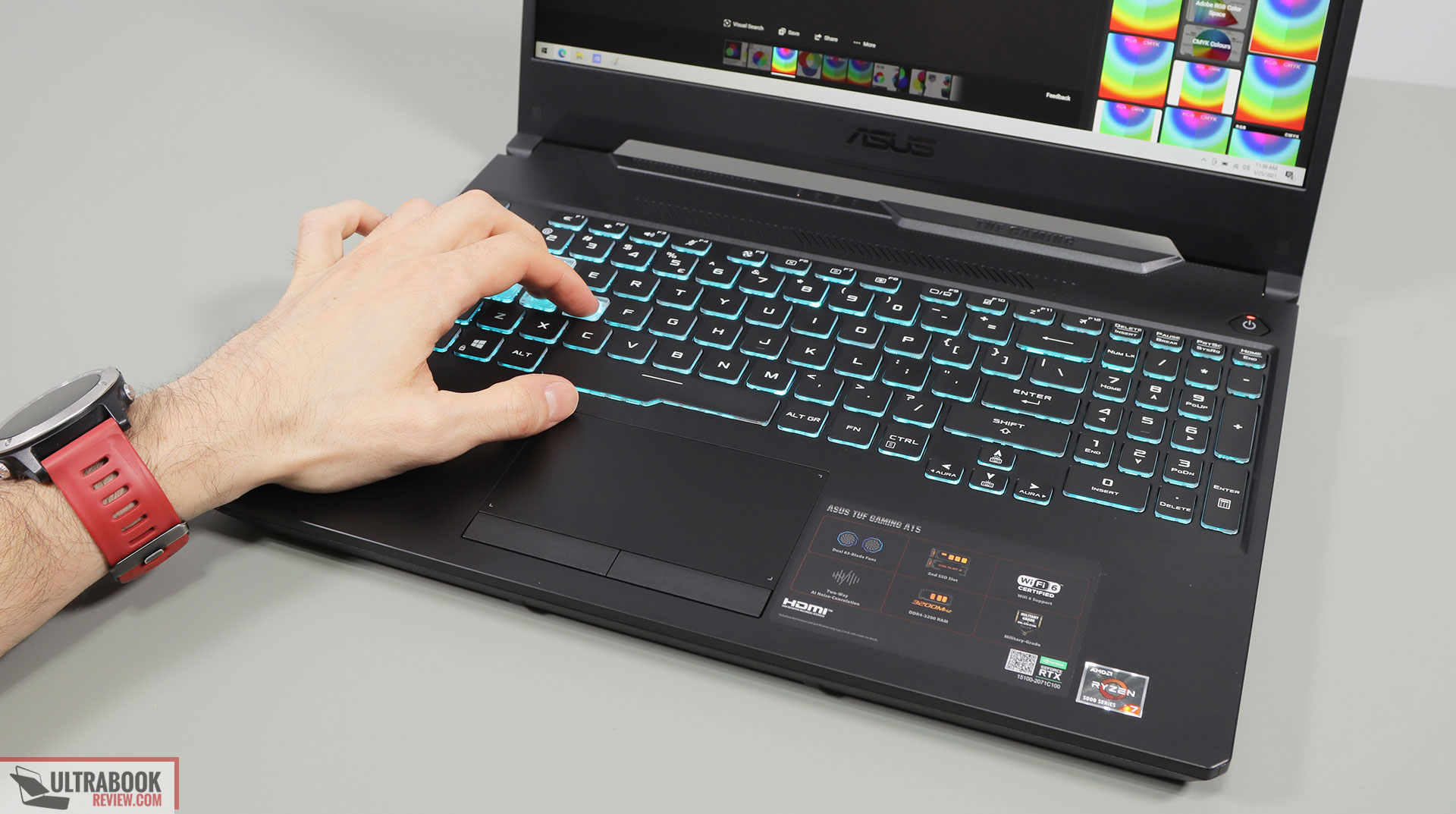
The smooth plastic keycaps feel nice to the touch and travel 1.8 mm into the frame. The feedback is a little soft and spongy, so might take some time to get used to, but I found this to be a reliable typer after using it for a couple of days. Much like I concluded before, most of you should get along fine with this keyboard, even if it’s not the absolute best in its segment.
The keys are also RGB backlit, with single-zone control through the AURA software embedded within the Armory Crate app. The illumination is uniform, bright-enough, and very little light shines uncontrolled from underneath the keycaps. Asus also made sure to implement a dedicated Caps-Lock indicator.
I couldn’t find a way to set a time-out for the illumination while the laptop is plugged in, you pretty much have to turn it off manually. It does time-out while on battery though, after about a minute of idle, and you can quickly reactivate the lights by swiping your fingers over the clickpad, just the way it should be done.
For mouse, Asus went with an immovable plastic touchpad and dedicated click buttons. It’s rather small for this day and age, but it works fine with everyday use, taps, and gestures. The click buttons are smooth and quiet, and unlike on the models tested last year, the touch surface feels firmer on this 2021 model and no longer rattles when tapped firmer.
As for biometrics, there are still none on this laptop.
Screen
Previous TUF A15s were only available with a subpar 144 Hz Panda panel, with slow response times and washed out colors by today’s standards.
This time around, the 2021 TUF A15s have been bumped to a much nicer panel option on the top configurations, the Sharp LM156M1JW26 previously only offered on the ROG models.
This panel is a bit brighter, 300+ nits peak brightness, offers richer colors (with nearly 100% sRGB gamut coverage), and faster response times, a must on a modern gaming laptop in order to eliminate lag and ghosting. The panel also supports FreeSync, a technology that takes care of tearing in games.
Here’s what we got in our tests, with an X-Rite i1 Display Pro sensor:
- Panel HardwareID: Sharp SHP1532 (LQ156M1JW26);
- Coverage: 98.7% sRGB, 69.3% AdobeRGB, 71.6% DCI-P3;
- Measured gamma: 2.31;
- Max brightness in the middle of the screen: 314.51 cd/m2 on power;
- Min brightness in the middle of the screen: 18.95 cd/m2 on power;
- Contrast at max brightness: 1088:1;
- White point: 6700 K;
- Black on max brightness: 0.29 cd/m2;
- PWM: TBD;
- Response: TBD (don’t have the right tool to properly test it)
The panel came well calibrated out of the box and proved uniform in luminosity/colors, as well as showed little light bleeding around the edges on dark backgrounds. I’m also seeing any flickering, but don’t have the proper tools to test for PWM.
Overall, this is a versatile screen for a mid-tier laptop, fine for daily use and an excellent option for gaming. At the same time, with only 100% sRGB color coverage, this might not suffice for creators or professionals looking for top color-accuracy, especially now when QHD panels with 100% DCI-P3 coverage are also an option on mid to mid-high level performance laptops.
Careful though that not all the 2021 TUF A15s configurations get this Sharp panel, and many of the mid-tier models will still ship with the 144 Hz Panda panel. Here’s what to expect from that one, in comparison:
- Panel Hardware ID: Panda LM156LF-2F01;
- Coverage: 62.1% sRGB, 43.2% AdobeRGB, 44.3% DCI P3;
- Measured gamma: 2.14;
- Max brightness in the middle of the screen: 253 cd/m2 on power;
- Contrast at max brightness: 811:1;
- White point: 7100 K;
- Black on max brightness: 0.20 cd/m2;
- PWM: No;
- Response: ~30 ms BTW.
Hardware and performance
Our test model is a top-specced configuration of the ASUS TUF Gaming A15, code name FA506QR, built on an AMD Ryzen 7 5800H 8C/16T processor, 16 GB of DDR4 3200 MHz of memory in dual channel, 1 TB of very fast SSD storage and dual graphics: the Nvidia RTX 3070 dGPU and the AMD Vega iGPU integrated within the AMD processor.
Before we proceed, keep in mind that our review unit was sent over by Asus and is a retail model identical to the ones you can get in stores, running on the software available as of late-January 2021 (BIOS 301, Armoury Crate 3.3.7.0, GeForce 461.23 drivers).
Update: As of January 28th, there’s an updated BIOS from Asus, as well as new GeForce drivers. We’ve rerun the benchmarks and gaming tests on this new software, and updated the early results.
Spec-wise, this 2021 ASUS TUF A15 is built on the latest AMD and Nvidia hardware. The Ryzen 7 5800H is the main-stream performance processor part of AMD’s Cezanne Ryzen 5000 platform, with 8C/16T, clock speeds of up to 4.4 GHz, and a designed TDP of 45W. However, Asus offers a couple of power profiles in the Armoury Crate that allows you to juggle with the power-envelope, thermals, and noise levels based on your needs. Compared to the previous Ryzen 7 4800H processor on the 2020 TUF A15s, the 5800H is a step forward in terms of IPC and single-core performance, as well as a refinement in many other ways. We’ll cover it in-depth in a separate article, once we get to test a couple more 2021 Ryzen laptops.
As for the GPU, Asus bumps the A15 series to an RTX 3070 this time around, able to run at around ~95W of power in sustained loads (90W default + 5W Dynamic Boost). Unfortunately, there’s no clear way to tell for sure whether Dynamic Boost is active and working on a 3000 laptop, you’ll have to check out the performance/power logs to figure it out. Dynamic Boost also doesn’t seem to work with every game now, but further support should be added by Nvidia with future drivers.
Anyway, the RTX 2070 in this TUF A15 is both faster and more powerful than the RTX 2060 OC 90W top GPU option available for the 2020 TUF A15, and is overclocked with ROG Boost.
As for the RAM and storage options, the laptop still comes with two accessible memory DIMMs and M.2 SSD slots. Our unit shipped with 16 GB of RAM in dual-channel and a very fast Sk Hynix SSD, somewhat surprising for an A15, given that Asus used to skimp on the drive quality in the past. I sure hope you’re getting the same kind of SSD in all regions.
For what is worth, though, this SSD heats-up quickly in our tests and ends-up thermally throttling, which takes a toll on the performance when transferring tens/hundreds of GB of data. I haven’t noticed any issue with real-life use, though, nor in terms of performance hiccups or abnormally high temperatures, but keep that in mind if you plan to transfer a lot of data at very fast speeds on and off this laptop.
Getting inside to the components is fairly easy, you just have to pop-up the back panel, hold in place by a couple of Philips screws.
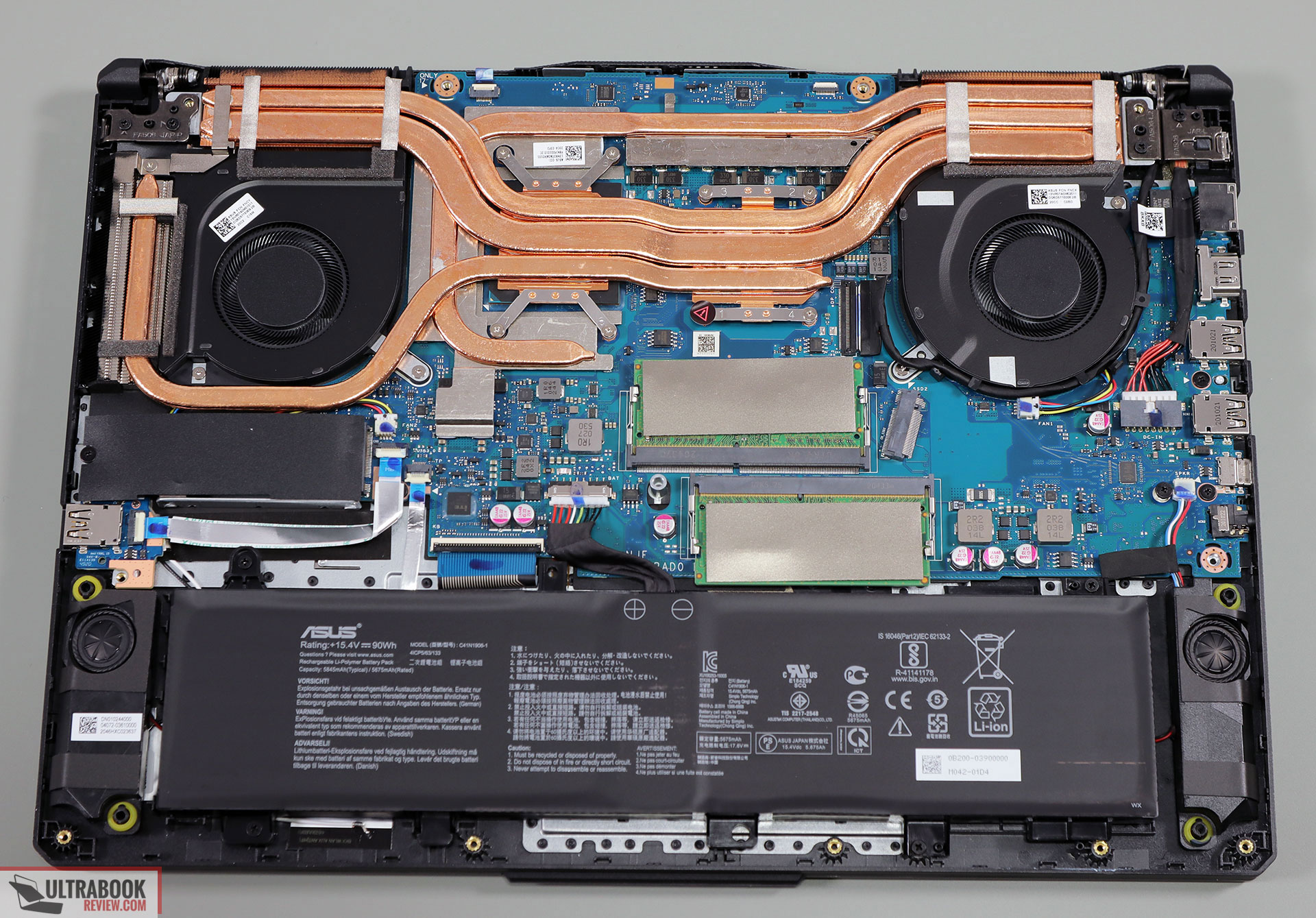
Specs aside, Asus offers three power profiles for the Asus TUF A15 FA506QR:
- Silent – quite fan-noise and limited CPU/GPU speeds and power – dGPU is limited to ~45W;
- Performance – balanced profile with stock CPU/GPU settings – GPU runs at 90-95W;
- Turbo – High-Performance profile with increased CPU power allocation and overclocked GPU (90-95W, +100 MHz Core/+120 MHz Memory).
Turbo is only available with the laptop plugged-in and is meant for gaming and other demanding loads. Performance is a jack-of-all-trades, while Silent is made for video and daily light-use.
There’s no Manual profile on this laptop, unlike on the ROG models. Further GPU overclocking is possible With MSI Afterburner, but don’t expect much, as the chip is already considerably overclocked on the Turbo mode.
As a novelty for this year, the TUF A15 completely shuts off the two fans while running the Silent profile, as long as the CPU/GPU stay under 60 degrees C, leading to a quiet daily-use experience. Here’s what to expect in terms of performance and temperatures with everyday multitasking, browsing, and video.
On to more demanding loads, we start by testing the CPU’s performance by running the Cinebench R15 test for 15+ times in a loop, with 2-3 seconds delay between each run.
The Ryzen 7 processor stabilizes at 75+W of sustained power on the Turbo setting, which translates in frequencies of 3.8+ GHz, temperatures in the 90-94 C, scores of 2100+ points, and the fans spinning at about 42-43 dB at head-level. We’re not seeing any performance degradation on any sort of throttling for the entire duration of the test. A later BIOS update causes the fans to spin faster in this test, at around 45-46 dB, with the same kind of performance, but slightly lower temperatures in the 88-90 C.
Switching over to the Performance profile translates in the CPU running at 65W and temperatures in the low 90s for the first 8-10 loops, with the fans spinning quieter, at 40-41 dB at head-level. After a while, the system decides to limit the CPU’s power to around 53-55 W, which causes a slight drop in performance, but also allows the CPU to run cooler, in the 80-85 degrees Celsius.
On Silent, the processor constantly runs at 50W with quieter fans (36-37 dB) and lower temperatures (high 70s C). It returns scores of around 1880 points, merely 10% beneath those registered on the noisier, hotter and more power-hungry Turbo profile.
Finally, the CPU power stabilizes at between 40 to 45 W on battery, on the Performance profile, with still excellent scores. Details below.
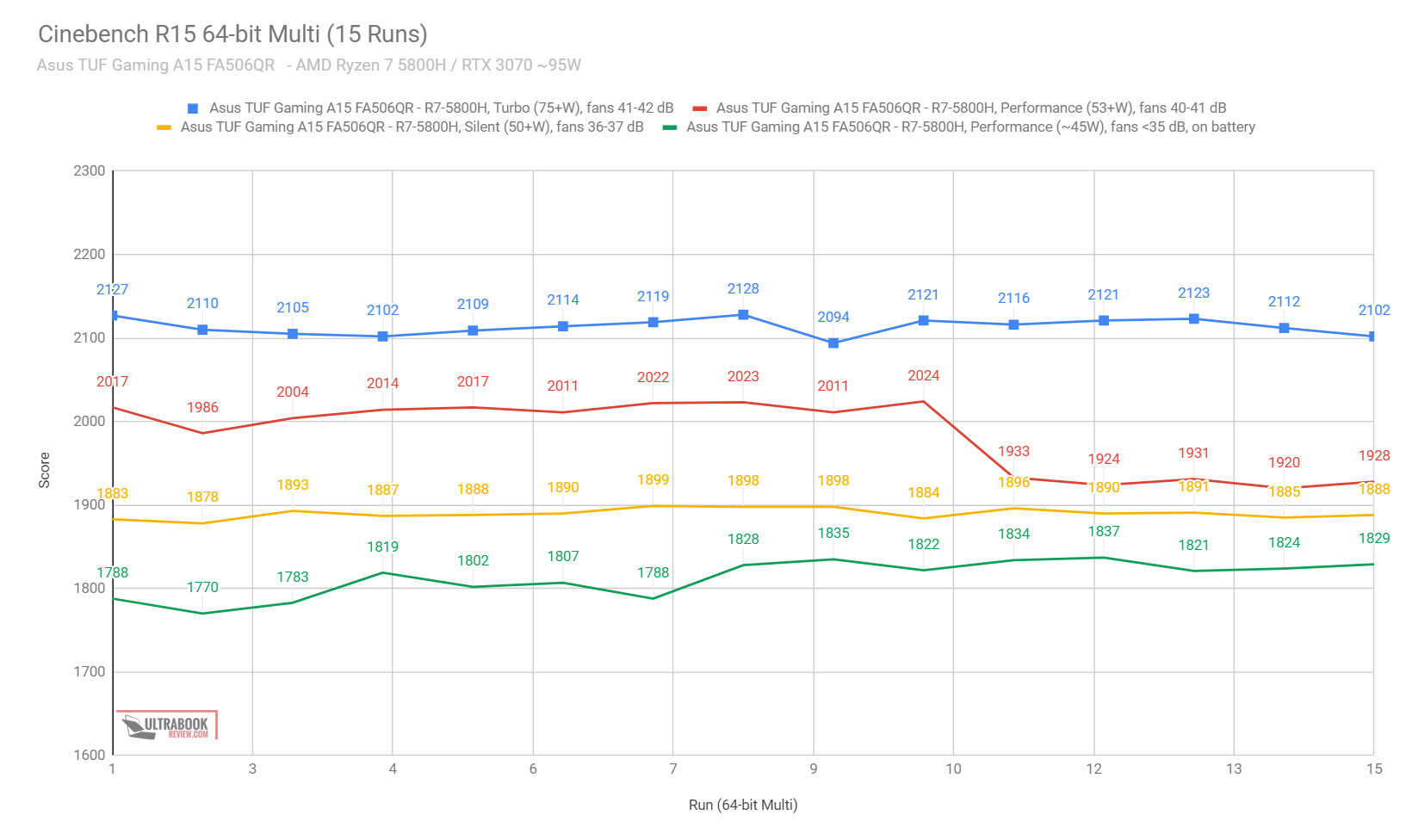
To put these findings in perspective, here’s how the Ryzen 7 5800H fares in this test against a couple of other AMD and Intel current processors. we’re looking at an increase of 12-15% over the Ryzen 7 4800H in the 2020 TUF A15 and 7% over the same processor in the 2020 Lenovo Legion 5. This is also 3% slower than the Ryzen 9 5900HX in the ROG Scar 17.
On the Intel side, the i9-10980HK trails this Ryzen 7 5800H implementation by 10-15%, while requiring more power and in a noisier laptop, while the mainstream 6C i7-10750H is hardly a match for any of the other options in this multi-threaded test.
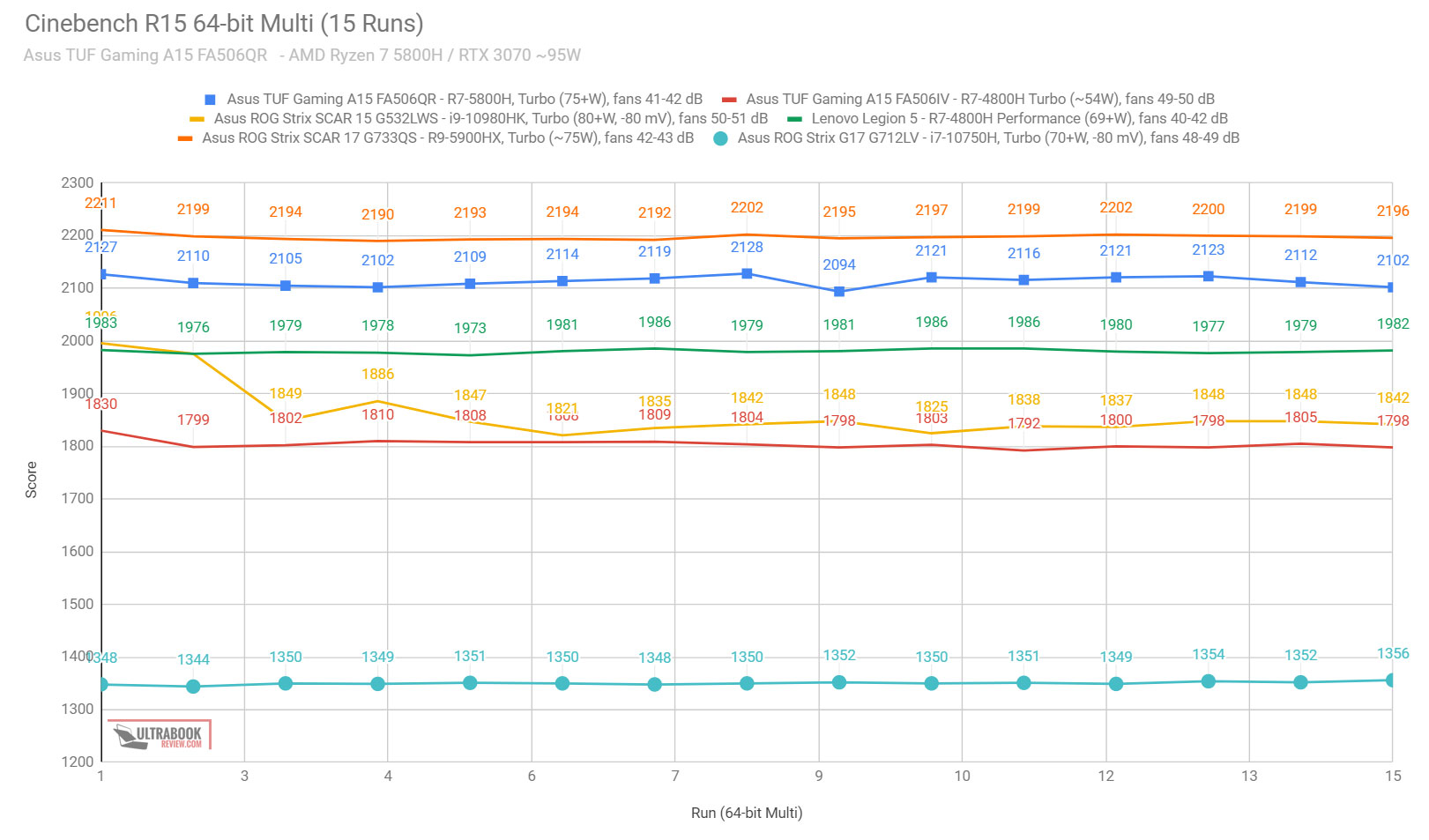
We then went ahead and further verified our findings with the longer Cinebench R20 loop test and the gruesome Prime 95, on the Turbo profile. The CPU stabilizes at 75+ W in Turbo on Cinebench R20, and only 65W in Prime95, with lower sustained temperatures in the 83-85 degrees Celsius.
We also ran our combined CPU+GPU stress tests on this notebook. 3DMark stress runs the same test for 20 times in a loop and looks for performance variation and degradation over time, and this unit passed it just fine. We haven’t run Luxmark 3.1, which also fully loads both the CPU and GPU at the same time, because this test is no longer properly supported by the Ryzen 5000 platform.
Next, here are some benchmarks. We ran the entire suite of tests and benchmarks on the standard Turbo profile. Here’s what we got.
- DMark 13 – Fire Strike: 21794 (Graphics – 24017, Physics – 24377, Combined – 11574);
- 3DMark 13 – Port Royal: 5550;
- 3DMark 13 – Time Spy: 9206 (Graphics – 9271, CPU – 8859);
- AIDA64 Memory test: -;
- Uniengine Superposition – 1080p Extreme: 6016;
- Uniengine Superposition – 1080p Medium: 17333;
- Handbrake 1.3.3 (4K to 1080p encode): 38.66 average fps;
- PassMark 10: Rating: 5027 (CPU mark: 22388, 3D Graphics Mark: 13187, Disk Mark: 26826);
- PCMark 10: 6924 (Essentials – 10291, Productivity – 9397, Digital Content Creation – 9316);
- GeekBench 5.3.1 64-bit: Single-Core: 1417, Multi-core: 7706;
- CineBench R15 (best run): CPU 2157 cb, CPU Single Core 236 cb;
- CineBench R20 (best run): CPU 4999 cb, CPU Single Core 564 cb;
- CineBench R23 (best run): CPU 12584 cb, CPU Single Core 1440 cb;
- x265 HD Benchmark 64-bit: 29.22 s.
Compared to the Ryzen 7 4800H + RTX 2060 90W configuration of the 2020 Asus TUF A15, this 2021 model ends up roughly 7-20% faster in multi-threaded loads, 15-25% faster in single-core loads and 30+% faster in the GPU tests such as 3DMark or Superposition. Impressive.
The CPU and GPU still run hot on this Turbo profile, with temperatures in the 80-90s for the CPU and 80+ for the GPU. Switching over to the Performance mode further increase these temperatures, with a slight toll on performance and a decrease in fan noise.
We also ran some tests on the Silent profile, if you’re interested in running demanding loads at lower noise levels of 35-38 dB.
- 3DMark 13 – Fire Strike: 20356 (Graphics – 22897, Physics – 21157, Combined – 10778);
- 3DMark 13 – Port Royal: 5263;
- 3DMark 13 – Time Spy: 8692 (Graphics – 8856, CPU – 7867);
- Uniengine Superposition – 1080p Extreme: 3683;
- Uniengine Superposition – 1080p Medium: 10229;
- Handbrake 1.3.3 (4K to 1080p encode): 37.42 average fps;
- PassMark 10: Rating: 4841 (CPU mark: 20791, 3D Graphics Mark: 10408, Disk Mark: 25683);
- PCMark 10: 6947 (Essentials – 10280, Productivity – 9903, Digital Content Creation – 8935);
- GeekBench 5.3.1 64-bit: Single-Core: 1409, Multi-core: 7259;
- CineBench R15 (best run): CPU 1926 cb, CPU Single Core 234 cb;
- CineBench R20 (best run): CPU 4424 cb, CPU Single Core 556 cb;
- CineBench R23 (best run): CPU 11467 cb, CPU Single Core 1429 cb;
- x265 HD Benchmark 64-bit: 32.18 s.
We’re still looking at excellent results, with barely any decrease in single-core tests, and a 5-15% toll in the multi-threaded CPU tests. The GPU ends up being limited in the longer tests, though, which we’ll further illustrate once we get to the gaming section below.
Finally, we also ran some Workstation related loads on this Ryzen 7 5800H configuration, on the Turbo profile:
- Blender 2.90 – BMW Car scene- CPU Compute: 3m 44s (Silent), 3m 22s (Turbo);
- Blender 2.90 – BMW Car scene- GPU Compute: 40s (CUDA), 18s (Optix);
- Blender 2.90 – Classroom scene – CPU Compute: 9m 52s (Silent), 8m 40s (Turbo);
- Blender 2.90 – Classroom scene – GPU Compute: 2m 30s (CUDA), 1m 6s (Optix);
- Luxmark 3.1 – Luxball HDR – OpenCL CPUs + GPUs score: -;
- SPECviewerf 13 – 3DSMax: 143.9 (Turbo);
- SPECviewerf 13 – Catia: 117.72 (Turbo);
- SPECviewerf 13 – Creo: 138.67 (Turbo);
- SPECviewerf 13 – Energy: 14.78 (Turbo);
- SPECviewerf 13 – Maya: 178.73 (Turbo);
- SPECviewerf 13 – Medical: 49.31 (Turbo);
- SPECviewerf 13 – Showcase: 73.78 (Turbo);
- SPECviewerf 13 – SNX: 19.42 (Turbo);
- SPECviewerf 13 – SW: 88.07 (Turbo).
And the newer SPECviewperf 2020 test:
- SPECviewerf 2020 – 3DSMax: 84.045 (Turbo);
- SPECviewerf 2020 – Catia: 56.84 (Turbo);
- SPECviewerf 2020 – Creo: 77.12 (Turbo);
- SPECviewerf 2020 – Energy: 22.98 (Turbo);
- SPECviewerf 2020 – Maya: 233.35 (Turbo);
- SPECviewerf 2020 – Medical: 28.04 (Turbo);
- SPECviewerf 2020 – SNX: 18.68 (Turbo);
- SPECviewerf 2020 – SW: 159.3 (Turbo).
The Ryzen 7 5800H ends up outmatching the Ryzen 7 4800H in the 2020 A15 by as much as 20% in Blender, and overall the 2021 system is a significant upgrade over the previous generation in these complex workloads simulated by the Specviewperf tests.
With these out of the way, let’s look at some games. We ran a couple of DX11, DX12, and Vulkan titles on the stock Turbo, Performance, and Silent profiles, on both FHD (internal screen) and QHD (external monitor) resolutions. Whisper Mode is enabled in GeForce Experience for the Silent profile.
Here’s what we got:
AMD Ryzen 7 5800H
+ RTX 3070 Laptop 95W
FHD Turbo
FHD Performance
FHD Silent (WM)
QHD Turbo
Battlefield V
(DX 12, Ultra Preset, RTX OFF)
118 fps (73 fps – 1% low)
112 fps (69 fps – 1% low)
60 fps (53 fps – 1% low)
– updating
Battlefield V
(DX 12, Ultra Preset, RTX ON, DLSS OFF)
82 fps (53 fps – 1% low)
78 fps (52 fps – 1% low)
60 fps (51 fps – 1% low)
-updating
Cyberpunk 2077
(DX 12, Ultra Preset, RTX OFF)
64 fps (52 fps – 1% low)
58 fps (50 fps – 1% low)
38 fps (28 fps – 1% low)
-updating
Cyberpunk 2077
(DX 12, Ultra Preset + RTX, DLSS Quality)
52 fps (39 fps – 1% low)
47 fps (38 fps – 1% low)
32 fps (27 fps – 1% low)
-updating
Dota 2
(DX 11, Best Looking Preset)
116 fps (60 fps – 1% low)
–
104 fps (57 fps – 1% low)
-updating
Far Cry 5
(DX 11, Ultra Preset, SMAA)
104 fps (77 fps – 1% low)
101 fps (77 fps – 1% low)
60 fps (53 fps – 1% low)
-updating
Metro Exodus
(DX 12, Ultra Preset, RTX OFF)
67 fps (36 fps – 1% low)
64 fps (34 fps – 1% low)
39 fps (28 fps – 1% low)
-updating
Metro Exodus
(DX 12, Ultra Preset, RTX High + DLSS)
55 fps (30 fps – 1% low)
54 fps (28 fps – 1% low)
–
-updating
Middle Earth: Shadow of Mordor
(DX 11, Ultra Preset)
157 fps (113 fps – 1% low)
152 fps (111 fps – 1% low)
60 fps (60 fps – 1% low)
-updating
Red Dead Redemption 2
(DX 12, Ultra Optimized, TAA)
83 fps (59 fps – 1% low)
78 fps (56 fps – 1% low)
42 fps (37 fps – 1% low)
-updating
Rise of Tomb Raider
(DX 12, Very High Preset, FXAA)
107 fps (49 fps – 1% low)
96 fps (48 fps – 1% low)
60 fps (49 fps – 1% low)
-updating
Shadow of Tomb Raider
(DX 12, Highest Preset, TAA)
93 fps (43 fps – 1% low)
90 fps (42 fps – 1% low)
60 fps (40 fps – 1% low)
-updating
Shadow of Tomb Raider
(DX 12, Highest Preset, TAA, RTX Ultra)
68 fps (36 fps – 1% low)
66 fps (36 fps – 1% low)
56 fps (34 fps – 1% low)
-updating
Strange Brigade
(Vulkan, Ultra Preset)
156 fps (118 fps – 1% low)
151 fps (114 fps – 1% low)
60 fps (57 fps – 1% low)
-updating
The Witcher 3: Wild Hunt
(DX 11, Ultra Preset, Hairworks On 4)
108 fps (83 fps – 1% low)
106 fps (82 fps – 1% low)
60 fps (59 fps – 1% low)
83 fps (68 fps – 1% low)
- Battlefield V, The Witcher 3 – recorded with Fraps/in-game FPS counter in campaign mode;
- Far Cry 5, Metro, Middle Earth, Strange Brigade, Red Dead Redemption 2, Tomb Raider games – recorded with the included Benchmark utilities;
- Red Dead Redemption 2 Optimized profile based on these settings.
We’re still working on the QHD tests and we’ll update the article in the next couple of days.
The HWinfo logs below show the CPU and GPU speeds and temperatures in Far Cry 5, Cyberpunk 2077, Battlefield V, and Witcher 3 on the stock Turbo profile.
While there are some differences between these titles, on average the RTX 3070 GPU runs at 90-95W and temperatures in the 80-83 degrees Celsius, while the CPU runs at between 25-40W, with temperatures in the 83-95 degrees Celsius.
FarCry 5 demands the most power out of the CPU, and as a result, the CPU averages ~95 C in this title, and the GPU runs closer to the stock 90W power profile, without Boost.
These are overall higher temperatures than on the 2020 Asus TUF A15, which averaged 2-5 degrees Celsius lower in the titles tested at that time. We are however looking at a significant performance boost between the two generations, of roughly ~20%.
Dota 2 is the exception in our tests, with both the CPU and GPU running at lower power and temperatures in this case. I’m not sure why, but this also happens on other RTX 3000 laptops that we’ve tested so far.
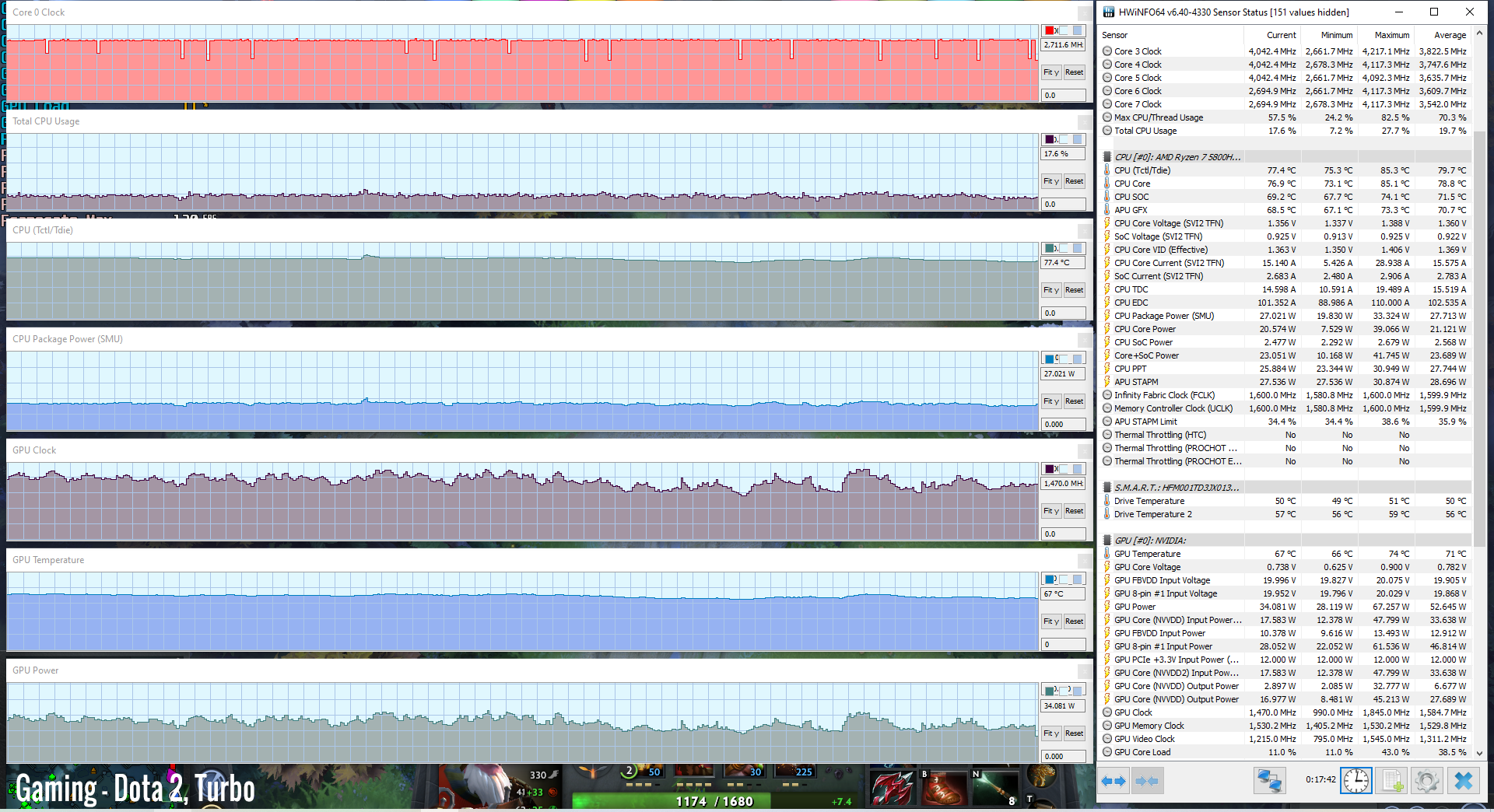
Raising the laptop from the desk helps lower the internal temperatures by 3-5 degrees on both the CPU and the GPU. This shows that the air-intakes on the bottom are still somewhat choked in this design, which makes sense, given the very slim rubber feet and the small amount of space under the laptop. Asus claim that’s intentional, in order to draw more fresh air from the top, through the keyboard, and make the contact areas more comfortable in longer gaming sessions.
Based on our tests, raising the laptop from the desk doesn’t significantly impact the case-level temperatures around the keyboard, so I still think that lifting up the laptop is worth it here, as it leads to temperatures in the 80-85 C on the CPU and 75-78 on the dGPU in most titles, with Far Cry 5 still being the exception. Throw in a cooling pad and those temperatures will drop even further.
We’ll further touch on this aspect in the next section and in a future detailed article.
For now, I’ll also add that running games on the Performance profile is hardly an option on this laptop. Yes, the fans end up running quieter, but both the CPU and the GPU run even hotter than on Turbo.
Quiet gaming is possible on the Silent profile, with a toll on the performance. The system imposes a 60 fps cap in most games, and both the CPU and the GPU are power limited in this mode, with the GPU running at roughly .99 GHz. More demanding titles such as Metro or Cyberpunk do not follow the same rule, as they cannot support 60 fps on a .99 GHz GPU frequency. Instead, the components seem to run at higher titles in these titles, and end up thermally throttling at around 87C for the GPU and 90-95 C for the CPU. That’s dangerous and I’d expect this behavior to be addressed with future software updates.
Finally, this TUF can also game while unplugged, with the GPU averaging 50W in this mode, enough for 60+ fps in titles such as Witcher 3 or Far Cry 5, with Ultra settings. It won’t last long past the hour while running games, though, but you can activate Battery Boost to limit the performance for longer runtimes.
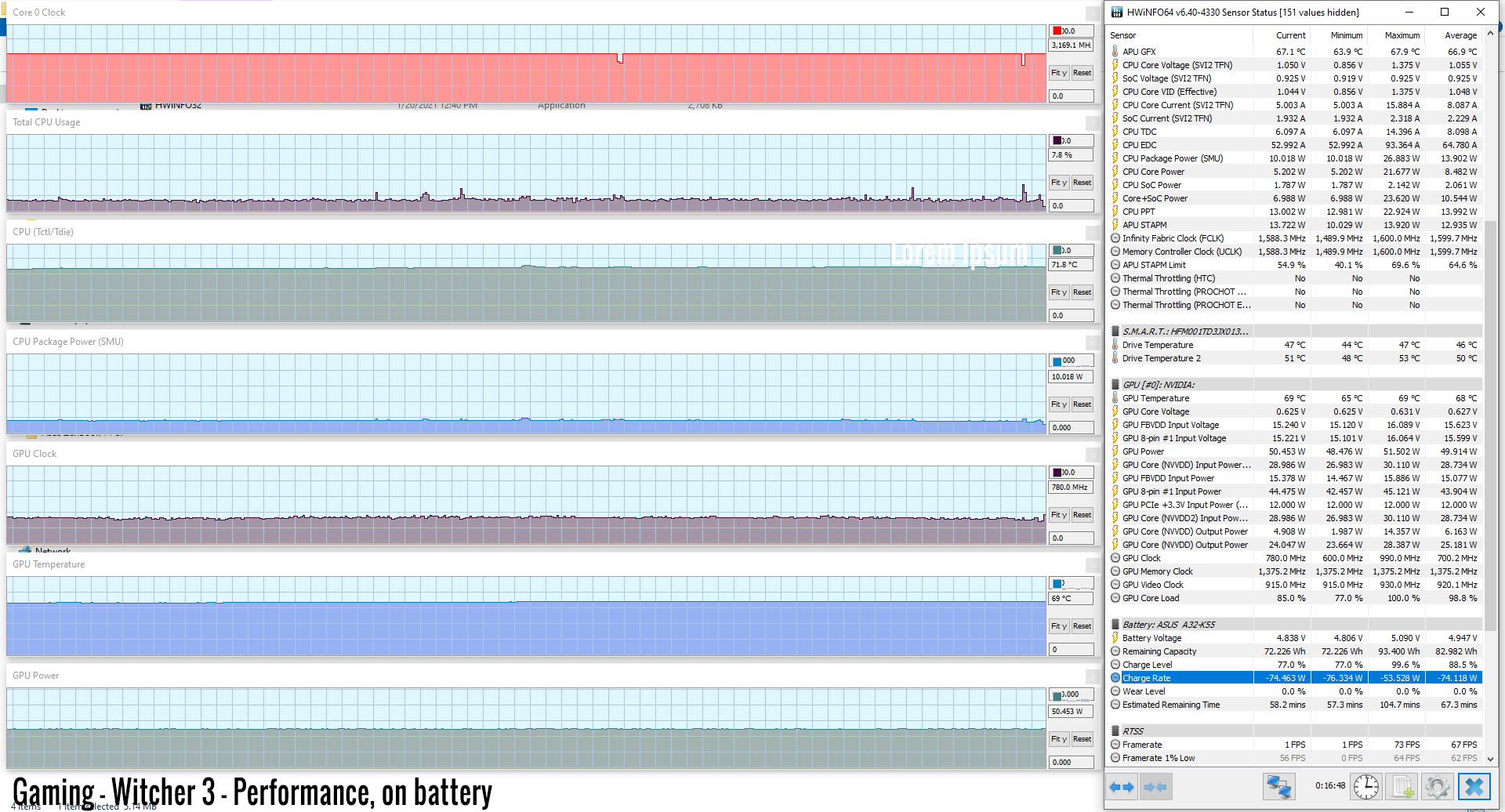
In conclusion, from what I can tell right now, the 2021 Asus TUF A15 is significantly faster than the previous generation in daily use, demanding loads and games, at least in this top-tier configuration with the RTX 3070 dGPU. At the same time, though, the components run even slightly hotter than on the previous model, and lifting the laptop from the desk or using a cooling pad are still recommended here.
Noise, Heat, Connectivity, speakers, and others
ASUS have slightly updated the thermal module of this 2021 TUF A15, slightly redesigning the heatpipes and partially opening the back for improved air intake into the two fans.
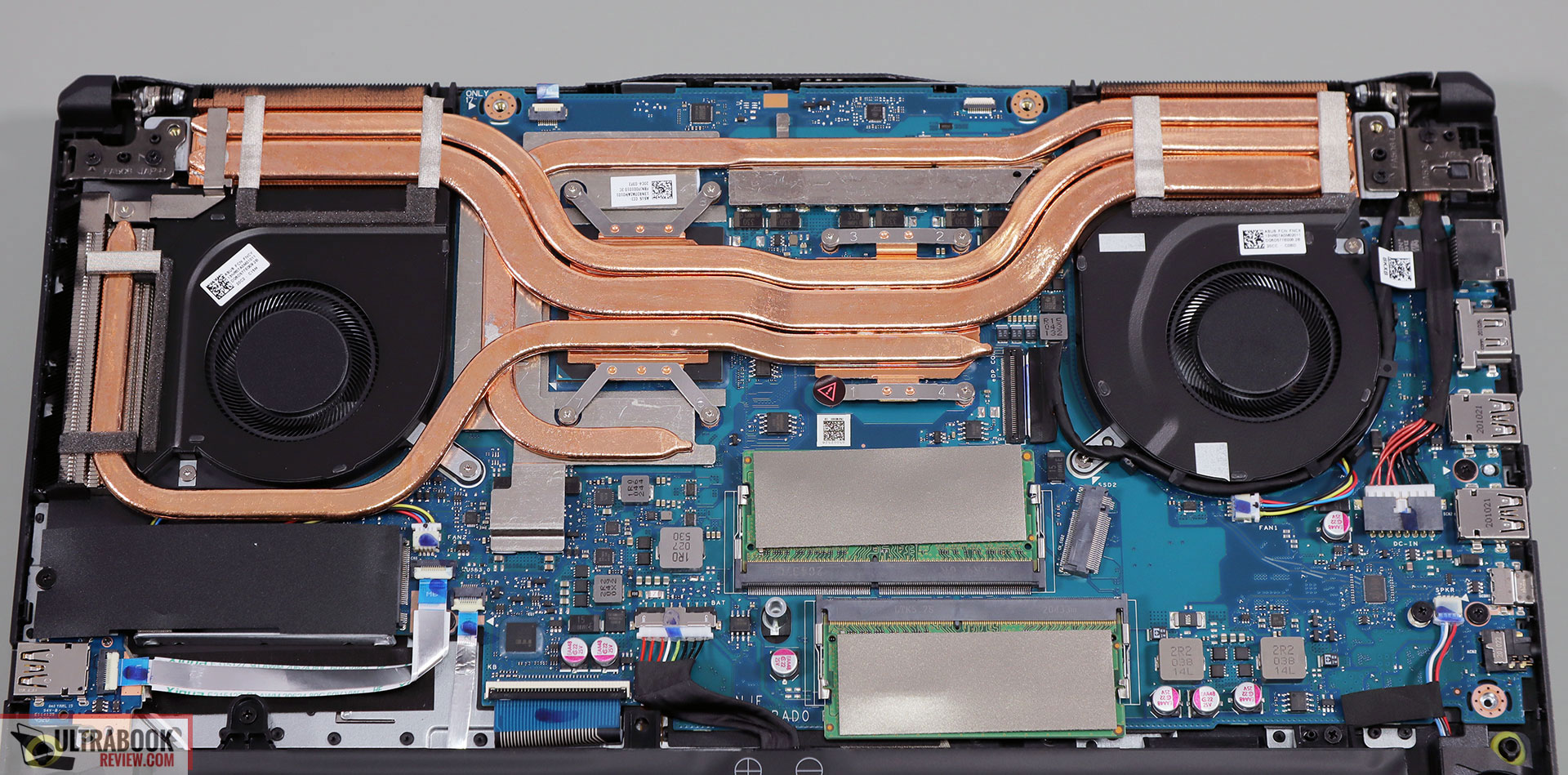
The main changes are:
- 10% higher capacity fans
- the secondary GPU heatpipe at the left now linked to the CPU as well
- the VRM heatpipe now goes over the CPU’s VRMs as well and hooks into the right radiator
- still regular thermal compound applied on the CPU, and not liquid-metal as on the ROG models
- a more open back, with partially unobstructed fans.
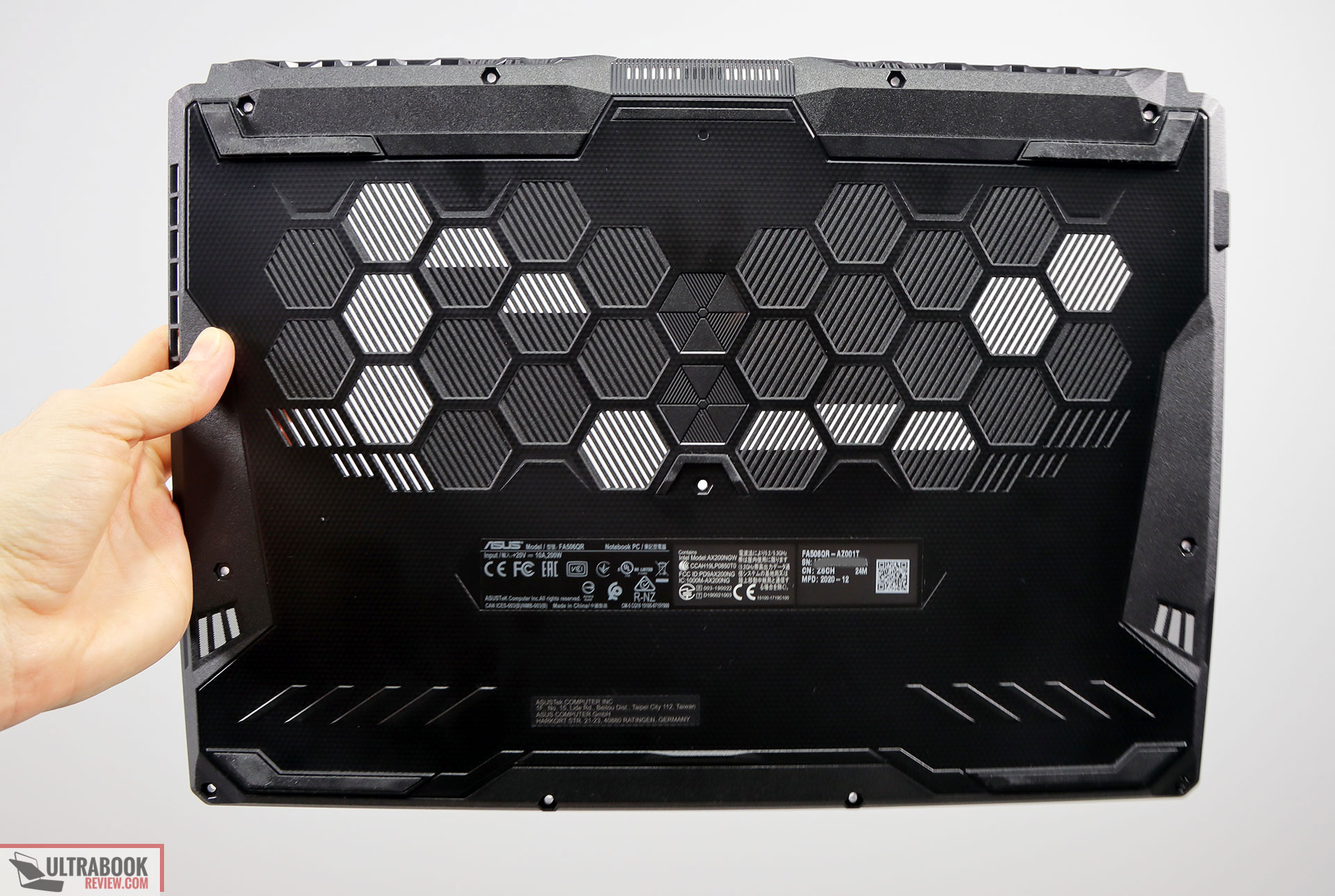
Still, based on our tests so far, these changes don’t make much of a difference when it comes to real-life gaming. The CPU still ends up averaging temperatures in the 85+ C, with the GPU in the 80+ C on the Turbo profile, or higher on the quieter modes.
In all fairness, the 2021 A15 seems to run 1-2 dB quieter on the Turbo mode than the previous model did, and a fair bit quieter on Performance. That doesn’t matter, though, given that the components average even higher temperatures on Performance.
The Silent profile is a welcomed update with daily use, as it allows the fans to switch off as long as the hardware doesn’t go above 60 C. Silent might also make sense for lighter gaming sessions, as it takes a toll on the performance, but the laptop ends up running quietly and cooly. It doesn’t seem to work properly in some recent games, though, at least for now.
As far as case temperatures go, we’re looking at 50-60 C in the hottest spots, but the WASD and arrow regions only reach perfectly comfortable temperatures in the mid-30s, helped by the placement of the fans underneath. The plastic arm-rest barely hits 30s C with games, so overall the laptop feels fine to the touch even in long gaming sessions, despite the fact that the internals run hot. The thicker plastic construction helps insulate the internal heat from the exterior here.
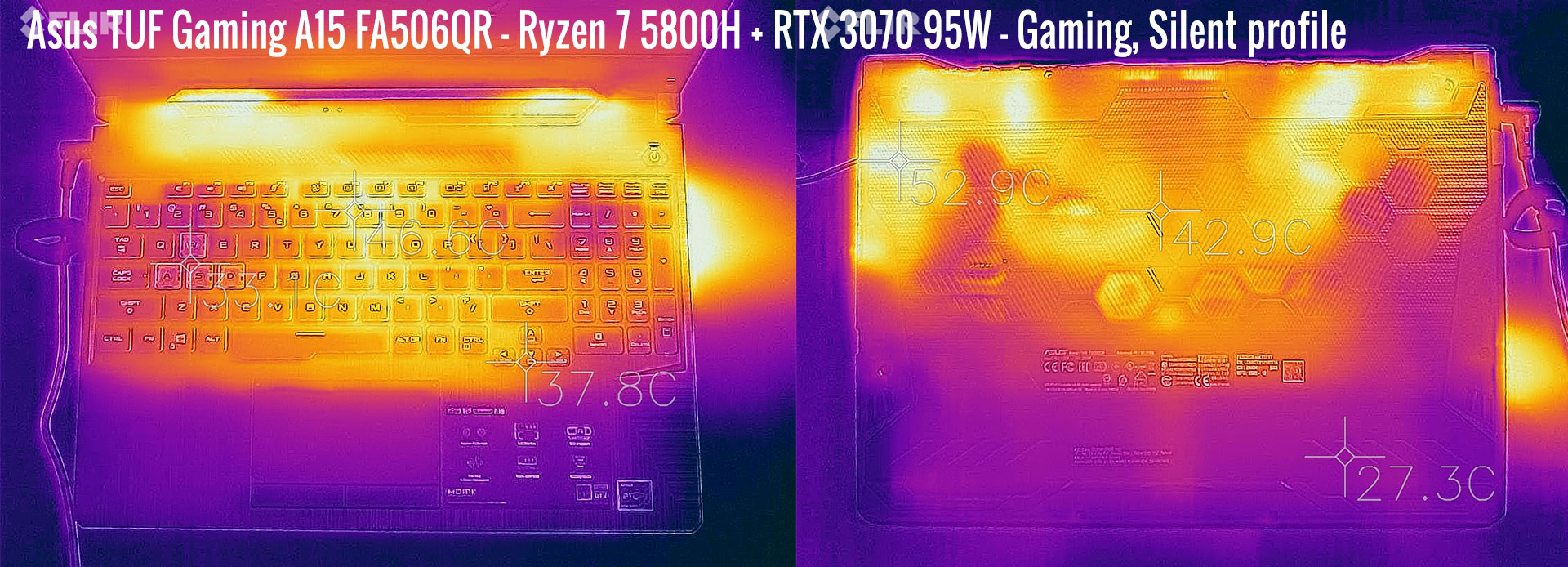
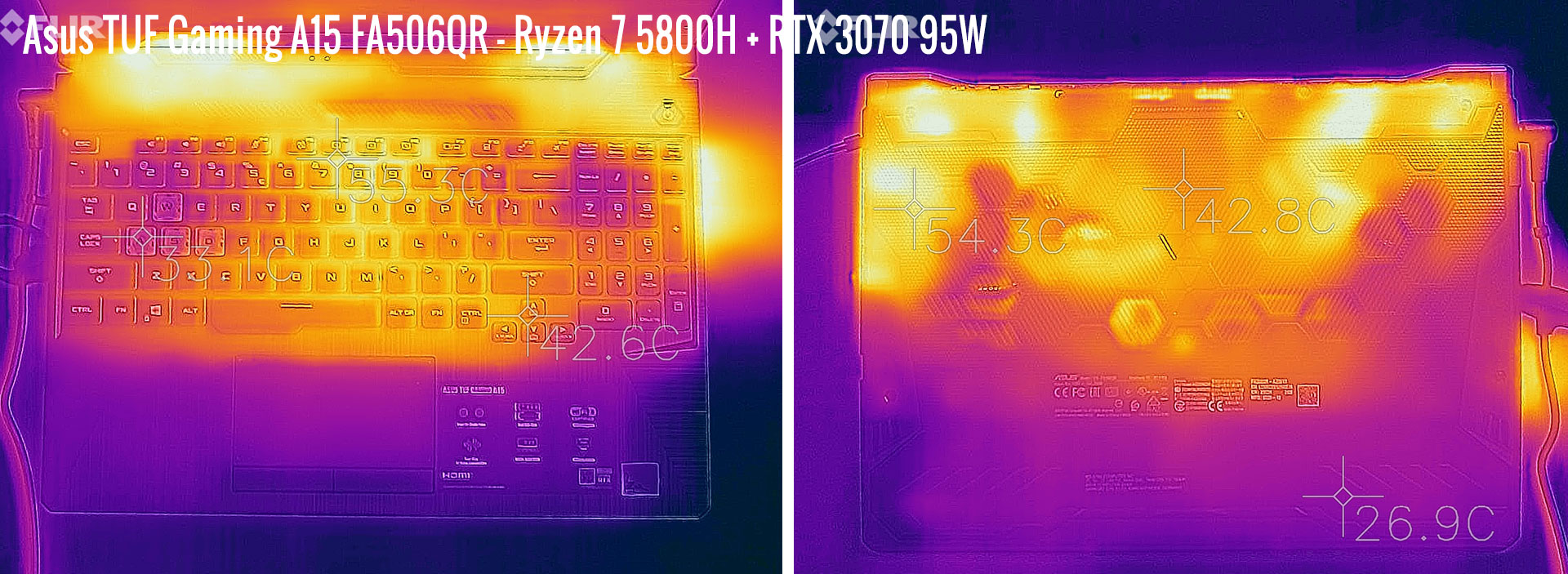
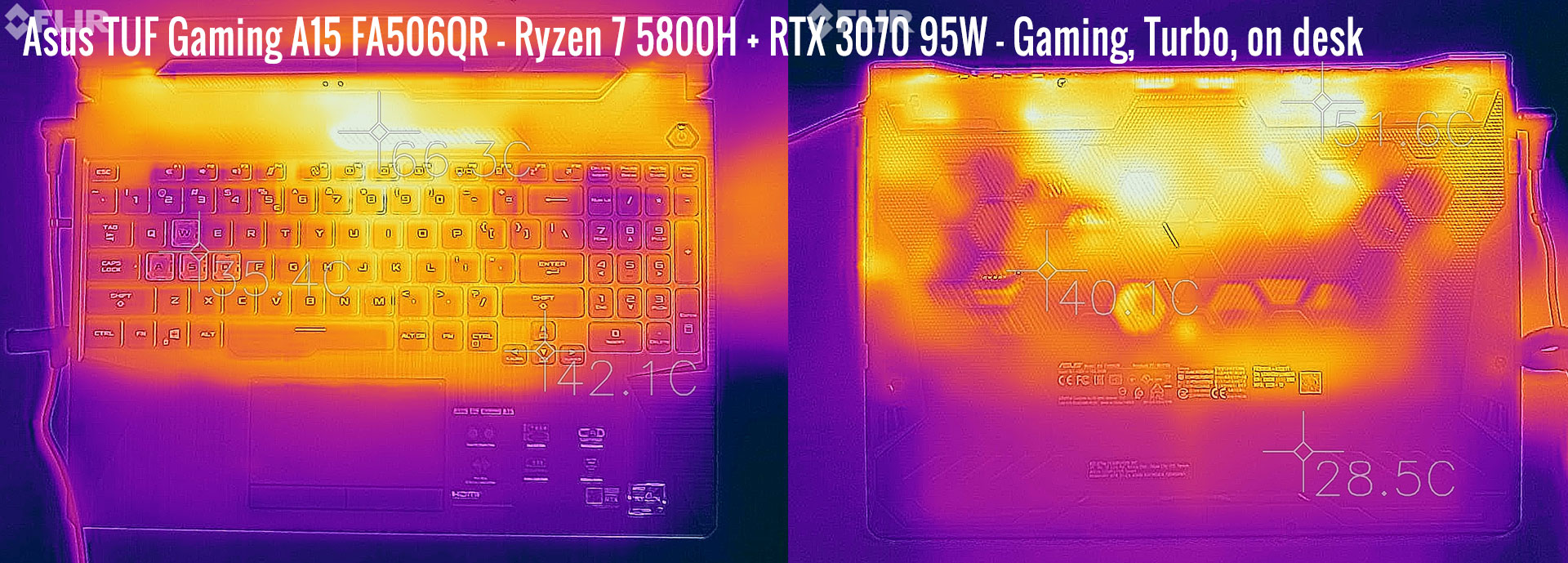
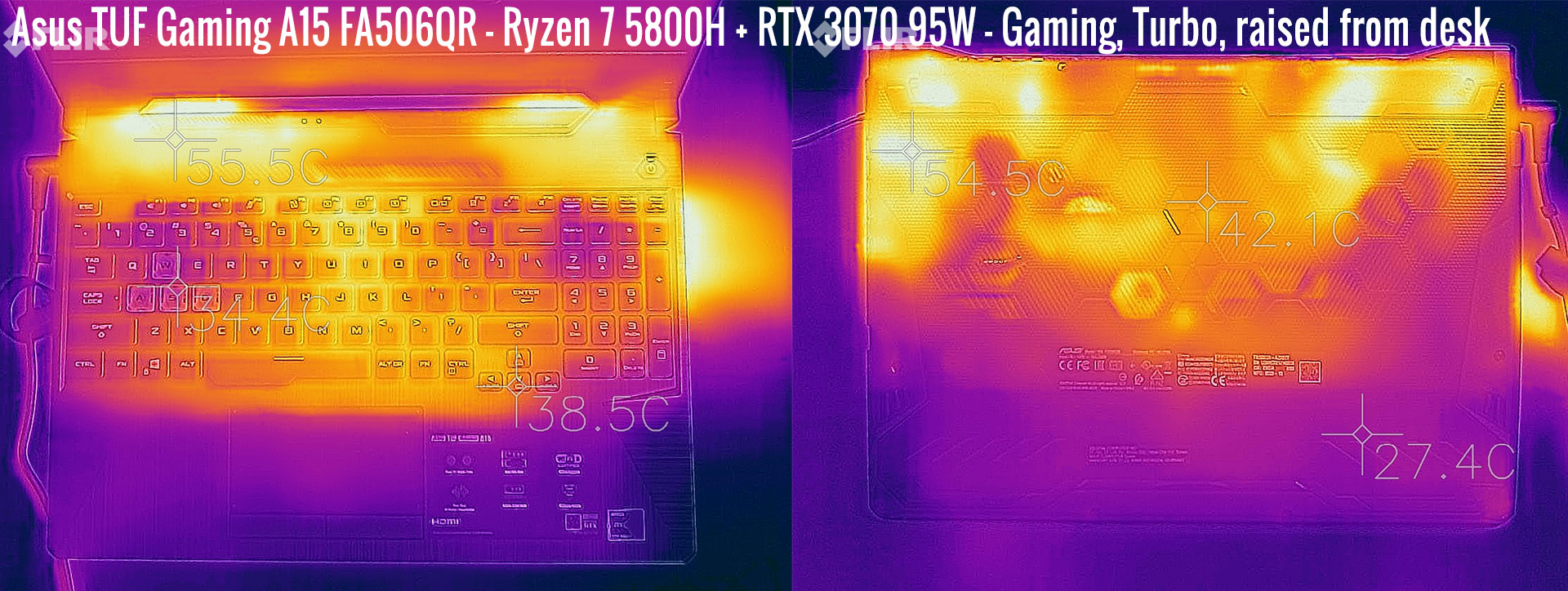
*Daily Use – streaming Netflix in EDGE for 30 minutes, Silent profile, fans at 0 dB
*Gaming – Silent – playing Far Cry 5 for 30 minutes, Silent profile, fans at 36-37 dB
*Gaming – Performance – playing Far Cry 5 for 30 minutes, fans at 41-42 dB
*Gaming – Turbo, on desk – playing Far Cry 5 for 30 minutes, fans at 45-46 dB
*Gaming – Turbo, raised from the desk – playing Far Cry 5 for 30 minutes, fans at 45-46 dB
For connectivity, there’s Wireless 6 and Bluetooth 5 through an Intel AX201 chip on this unit, an update from the WiFi 5 in the previous generation, as well as Gigabit Lan. Our sample performed well on WiFi both near the router and at 30+ feet with obstacles in between.
The audio hasn’t changed from the previous TUF A15s and is about average for a mid-tier gaming laptop, with only middling volumes of 75-77 dB at head-level, and little bass. Our unit didn’t get AudioWizard preinstalled, so it lacked the software processing that might make a difference in actual use. Still, if audio quality is important for you on a laptop, going with a nice pair of headphones is a must here.
Finally, the camera is placed on top of the screen, flanked by microphones. It’s OK for occasional calls, but grainy, so don’t expect much.
Battery life
There’s a 90Wh battery inside all the 2021 TUF Gaming A15 variants. Previously, Asus also offered versions with a 48 Wh battery and a HDD cage, but that’s no longer available for the 2021 model year.
Here’s what we got on our review unit in terms of battery life, with the screen’s brightness set at around 120 nits (~70 brightness).
- 8.5 W (~10+ h of use) – text editing in Google Drive, Silent Mode, screen at 70%, Wi-Fi ON;
- 7.5 W (~12+ h of use) – 1080p fullscreen video on Youtube in Edge, Silent Mode, screen at 70%, Wi-Fi ON;
- 6.2 W (~14+ h of use) – Netflix fullscreen in Edge, Silent Mode, screen at 70%, Wi-Fi ON;
- 12 W (~7+ h of use) – browsing in Edge, Performance Mode, screen at 70%, Wi-Fi ON;
- 65 W (~1+ h of use) – Gaming – Witcher 3, Performance Mode, screen at 70%, Wi-Fi ON, no fps limit.
These are some solid runtimes and significantly better than what we got on the 2020 A15 when tested. The system automatically switches the screen to 60Hz while on battery and on the iGPU, something I wish every manufacturer would implement on their products. There’s also an iGPU/dGPU toggle in Armoury Crate that you can use to completely shut off the Nvidia card while unplugged, making sure no rogue program running in the background would wake it up and eat into your battery life.
This TUF A15 FA506QR configuration comes with a 200W power-brick, smaller and lighter than the 230W variant on the previous top A15 models. The battery fills up in about 2 hours, with fast-charging for the first half an hour, and USB-C charging is not supported.

Price and availability
The 2021 TUF Gaming A15 FA506 is not widely available in stores at the time of this article.
Over here our test model is listed at around 1500 EUR, with the Ryzen 7 processor, RTX 3070 graphics, 16 GB of RAM, 1 TB of SSD storage and the 240 Hz screen. That’s slightly more expensive than the previous top-configuration of the 2020 A15, with the RTX 2060 GPU and 144 Hz screen.
Lower specced models are expected in the near future, but not yet listed here.
Follow this link for updated configurations and prices in your region at the time you’re reading this article.
Final thoughts
This 2021 TUF Gaming A15 improves on the previous generation in a few different ways, but it doesn’t seem to fix what most reviewers have complained about throughout the last year: the high CPU/GPU temperatures in longer gaming sessions.
In fact, based on our review unit, which is the higher-specced configuration running on a Ryzen 7 processor and RTX 3070 graphics, this 2021 A15 averages even slightly higher internal temperatures than we recorded on the 2020 Ryzen 7/RTX 2060 model when we reviewed that. Not by much, but the CPU ends up at 85-95 C in most titles, with the GPU averaging 80+ C, both on the Turbo profile, which is the most thermally optimized profile. However, lifting the A15 from the desk in order to improve the air intake into the fans and underneath the laptop helps lower these temperatures by 2-5 degrees, and I’d expect a capable cooling pad could help even further.
Now, it’s important to remind you that even 85-95 C on the CPU and 80+ C on the GPU are within the component’s thermal design limits, and theoretically, you should be fine gaming for years with this sort of temperature. I for one do prefer gaming laptops that tend to run a little cooler, in the 80-85 for the CPU and 75 on the GPU or lower, as electronics and heat don’t cope well together and I worry about long-term reliability issues. Asus are pushing the performance to the max here and somewhat sacrifice these CPU/GPU temperatures in the process, and I guess that’s alright for a Max Performance profile, but perhaps it would be wise for them to offer consumers like myself a more usable mid-level profile as well, something that can still game well-enough, but keep both the temperatures and the fan noise in check.
Bottom point, if you were hoping this updated TUF A15 will run significantly cooler than before, well, it doesn’t. I for one can’t say I’m surprised, the 2020 and 2021 A15s are mostly the same internal design, with only some tweaks for the updated model, but this now has to cope with higher power components on this tested configuration, in comparison to its predecessor. Hence, it runs hotter, and that might be a deal-breaker for some of you.
Thermals aside, the 2021 TUF A15 is faster across the board in daily use, demanding workloads, and games. It also runs more efficiently on battery and quieter with daily use, with the fans now able to shut off completely and allow for a silent experience.
On top of these, Asus finally put a good screen on the TUF Series, the 240 Hz fast panel with 100% sRGB colors, previously only an option on the ROG models.
All these combined should once more put the TUF Gaming A15 on many maps this year. I’d expect it’s still going to be competitively priced in most regions, although for now, the RTX 3070 configuration comes at a premium over the top-specced 2020 model. Again, expected, given you’re getting a higher tier GPU and 240 Hz screen now.
As for whether this is a proper match for last year’s top mid-range AMD gaming laptops, such as the HP Omen 15 and the Lenovo Legion 5, that’s hard for me to tell right now. Looks like Asus are once more among the first to bring a new generation Ryzen + RTX laptop to the market and this time with a better screen and higher-end GPU, but the hot temperatures with games are still an inconvenience that might push some of the potential buyers into waiting for the updated competitors. Not sure whether those will be able to match the A15 in terms of specs, pricing, and availability, though, so you’ll just have to decide based on the options and prices in front of you at the time you’re in the market for one of these laptops.
That’s about it for our review of the Asus TUF Gaming A15 FA506QR 2021 update, but I’d love to hear your thoughts on it, as well as your questions and feedback. Get in touch in the comments section down below.
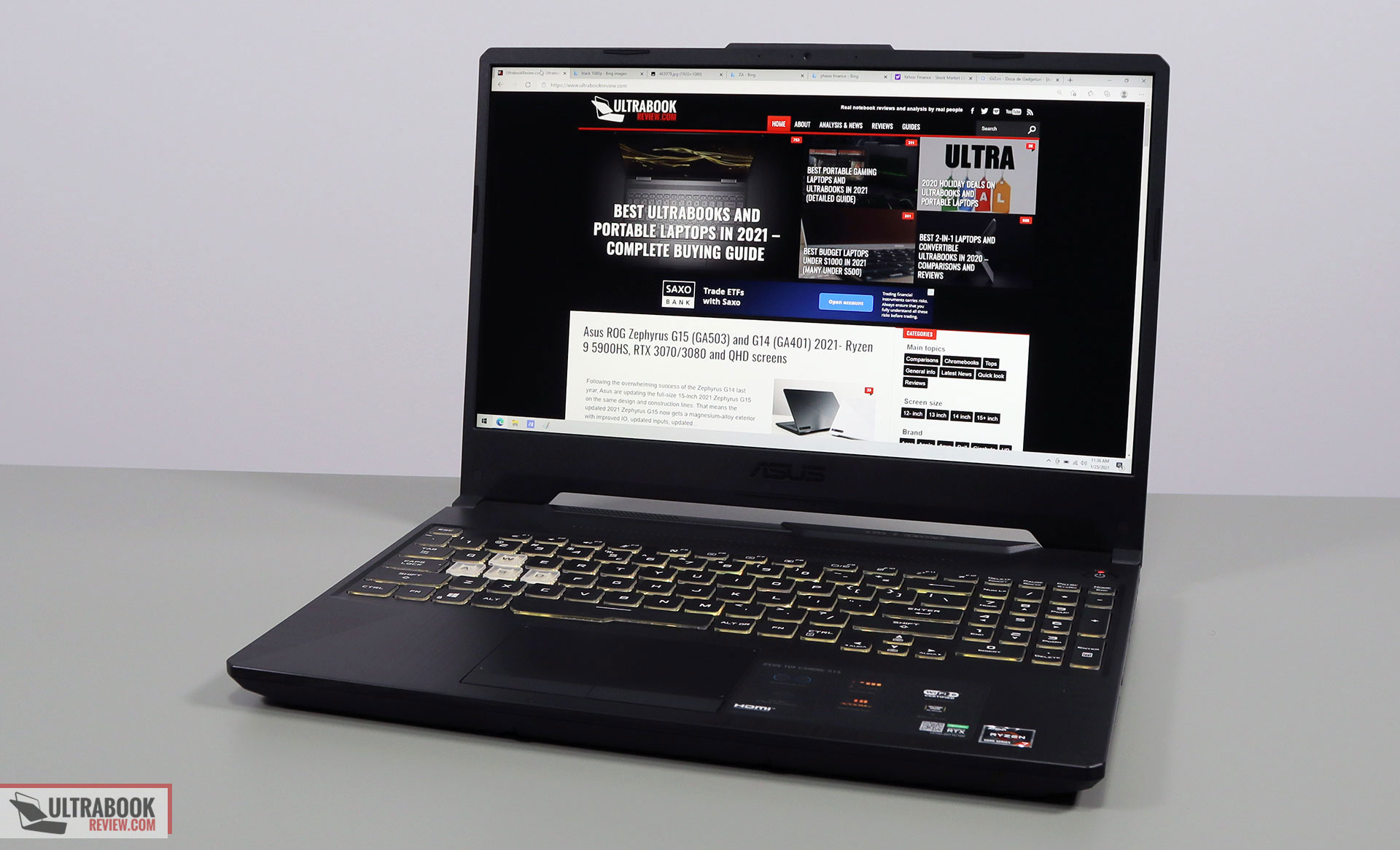
Disclaimer: Our content is reader-supported. If you buy through some of the links on our site, we may earn a commission.
Navigation: Ultrabookreview.com » 15.6 inch or larger
Our content is reader-supported. If you buy through some of the links on our site, we may earn a commission. Terms


Review by: Andrei Girbea
Andrei Girbea, Editor-in-Chief. I’ve a Bachelor’s in Computer Engineering and I’ve been covering mobile technology since the 2000s. You’ll mostly find reviews and thorough guides written by me here on the site, as well as some occasional first-impression articles.
. I’ve a Bachelor’s in Computer Engineering and I’ve been covering mobile technology since the 2000s. You’ll mostly find reviews and thorough guides written by me here on the site, as well as some occasional first-impression articles.






